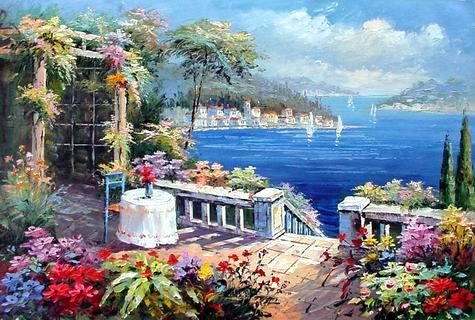Begin your oil painting by sketching your composition onto stretched canvas, canvas panel, Masonite or any other surface that is prepared to receive paint. When sketching your composition you can choose from these popular methods: Vine charcoal, pencils that are water-soluble, or sketching out in oil paint. Vine charcoal works well and it can be erased or wiped off with a damp cloth. Water-soluble pencils are terrific as they can be spread out or thinned with a damp brush. If you are at a level where you are comfortable doing so, sketching out your composition in oil paint is also very effective. This is not quite as forgiving as vine charcoal or pencil – not for the faint of heart!

Once you have a composition you are happy with, it’s time to investigate a few techniques for applying your oil paint. But what style do you want to use? Here are a few suggestions:
Using a painter’s knife (or palette knife) is a great method for building up texture without ‘fussing’ with details. With a minimal variety of knives, you can vary the amount of paint applied as well as the width of the stroke. Another bonus to painting with knives is the easy removal of paint – just scrape it off and re-apply.
For those who are more advanced and want a challenge, try glazing. Using black & white paint begin by creating your underpainting – your composition. Pay special attention to areas that will show highlights and shadows as it will be important when applying the glaze. When your underpainting is completely dry you can begin applying your glaze. The glaze layers are nothing more than extremely thinned-out oils in colour. The glaze layers are built up until you achieve the effect you want. It takes longer to complete this type of painting due to the drying time of the original underpainting and the building up of glaze layers. But the end result can be amazing.
An interesting style is one where you apply your paint using thick paint in heavy brush strokes, making sure that the strokes remain intact. Don’t fuss with your strokes or over-work them. These are the spirit of the piece! The result is a painting that shows life and movement.
For those who like to complete a painting in one day, there’s the wet-on-wet technique. Instead of applying layers of paint and waiting for them to dry, apply your oil paint in layers beginning with the darkest and building up layers of lighter colours on top – while the paint is still wet. One danger in using this method is that you could ‘muddy’ your colours. But with care and diligent execution, wonderful paintings can be created. This is the method used by artists like Bob Ross, Gary Jenkins, and William Alexander.
